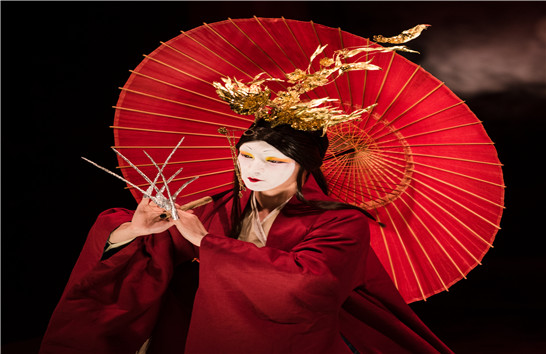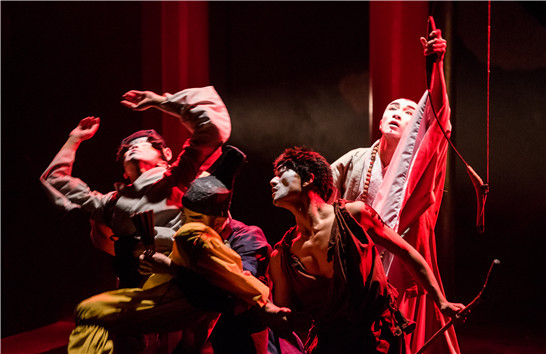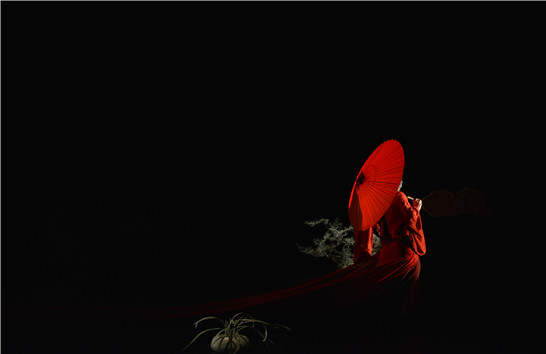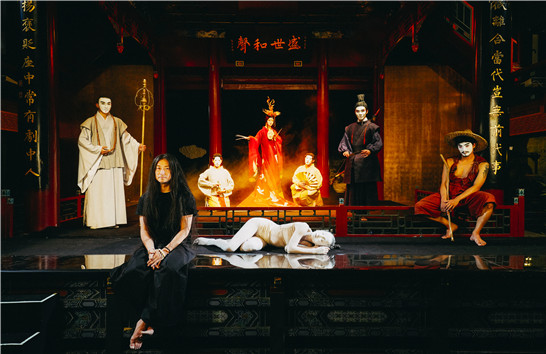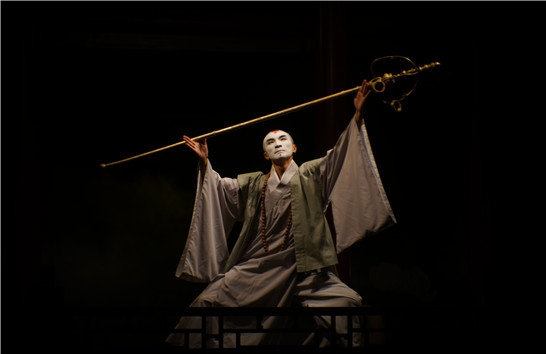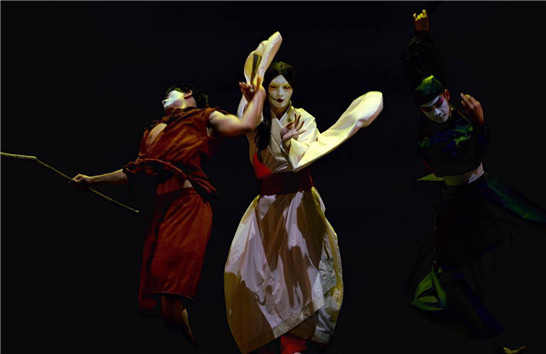China
Directed by Zhao Liang
Presenter Zhao Liang ART
Beijing Kind Giving Culture & Media Co. Ltd.
Acknowledgements:
China National Arts Fund 2015 Projects
Zhengyici Ancient Theater
Beijing Dance Academy Youth Dance Group
Beijing Dragon Lily Art Media Co. Ltd.
Beijing Yokya Cultural & Communication Co., Ltd.
WHEN:
23rd Oct. 2018, 19:00
24th Oct. 2018, 19:00
WHERE: Poetry Square
Duration: 70 minutes (without intermission)
No Lines, without subtitles

Reviews
Should we let go of mundane chores and turn to a cup of unhurried tea, with no affected plan or purpose, to elevate ourselves into a whole new dimension by following an unpredicted predestination. It is the composure gained from a simple cup of Zen Tea that answers a whole rainbow of confusions.
― Feng Shuangbai, Vice President of Chinese Dancers Association
Grass and trees are eternally beautiful, while humans are not. Zhao Liang’s dance performance allowed us to feel concretely the beauty of grass and trees.
― Feng Tang, poet and writer
Walking along Zhao Liang’s own path, a lot more on the stage is conveyed than simply the dancers’ bodies. The choreography has become freer and more composed, and those mysterious things, clearly defined characters and true things become increasingly tangible. The choreography is richer, warmer and gives us easier access to the core of the heart. I like the Character “Wugou”, a role just like moonlight in immediate proximity to darkness. Congratulations to Zhao Liang!
― Huang Liaoyuan, art collector and exhibition planner
Bravo! It is so weird, sexy, fascinating, sullen, like a dream, feeling half-awake and drunk on the unconscious.
― Meng Jinghui, theatre director
Zhao Liang’s dance work consists of three distinct features: visual expression from the Orient, the “language structure” of modern dance, and the tempo of narrative literature, all of which together created an intriguing and unique realm of dance.
― Yue Minjun, painter
Awards:
Premiered for the China-German Cultural Year in Berlin in 2012; Opening performance of the “Chinese Dance for 12 days” for the NCPA; 2015 “China National Arts Found” Funded Project; Invited to perform at the National Theater in Seoul, South Korea; 2016 China National Small Theater Boxing Champion; Israel Susan Dance Center invited to perform; Edinburgh International Festival of the Arts; Opening ceremony of Shanghai 1862 Fashion Art Center; Beijing Zhengyici Ancient Architecture Edition Box Office Champion

About The Tea Spell
The Tea Spell originated from a cultural relic unearthed in Famen Temple in China—first class royal teaware for the Emperor Xi Zong (His Majesty Li Xuan). For the first time ever, this dance brings the three holy relics of Famen Temple onto the stage from the perspective of cultural relics, constituting the middle chapter of Trilogy of Desire and Spirituality by the renowned dancer Mr. Zhao Liang. Taking tea as the starting point and dance the masterstroke, a hallucinatory journey embarks on the ocean of Zen.
This work won the support of China National Arts Fund in 2015, and has been performed abroad many times for the purpose of international exchange on behalf of China’s modern dance. In performance, our male actor plays the female role, Miss Teaspell, and encounters other male characters—Woodcutter, Gaoshi, the Monk and others, thereby creating romantic visions, feedback, reflections and imaginings.
These several characters respectively metaphorize the existence of different individuals in different dimensions and spirits. Each movement creates conflicted dramaturgy, each scene unfurls an artwork, and each chapter examines the heart, thus leading the audience through an imaginary, archaic and secluded experience to a multi-sensory enlightenment and pleasure bestowed by an ability to perceive the slightest change in the universe. It is because of its appealing and unaffected presentation that Zhao Liang was regarded as the “Shepherd from the Orient” in Germany.
The Tea Spell integrates Chinese traditional culture and Western modern culture, boosting oriental aesthetics and philosophical dialecticism to another level in art performance. Both the sensory experience and internal spiritual enlightenment of this dance performance demonstrate the longstanding, internationally high-production quality, and lofty pursuits in the arts of Zhao Liang.

Credits
Producer/Director: Zhao Liang
Artist Counselor: Feng Shuangbai
Cultural Consultant: Liu Xirong
Project Manager: Hou Ke
Project Assistant: Hu Sile
Stage Design: Gong Xun
Costume Design: Xu Rui
Make-up: Wang Jia
Music Arrangement: Li Juntong, Liu Sichao
Specially Invited Female Singer: Yang Jima
Mask Making: Ding Jie
Sounding Design: Mao Liang
Lighting Design: Liu Hengzhi
Hats Design: Sui Yida
Poster Design: Su Hang
Poster Photography: Zhang Dan
Poster Calligraphy: Sun Chu
Stage Manager: Li Junlong, Tang Jilong
Rehearsal Director: Cao Peizhong
Artists:
Tea Girl Zuo Yan
Tea Boy Cao Peizhong
Woodcutter Song Yulong
Dignitary Zhang Yixiang
Teafairy Yang Hailong
Purewhite Amy Grubb
Monk Zhang Chao

About Zhao Liang
Zhao Liang is a contemporary dance artist, and the artistic director of Zhao Liang ART.
As a pioneer practitioner of the new generation of Chinese modern dance, Zhao Liang has been not only an independent artist in the dance field in recent years, but also one of the most prominent dancers in China’s new generation of dancers. He is the first Chinese to win the Roman International Modern Dance Competition. He once won the Chinese Governmental Cultural Award, and the Double Gold Award for Performance and Choreography of Lotus Award, which is the highest honour in Chinese Dance. In recent years, Zhao Liang has been praised as the "Soul Dancer" and "Choreographer of Genius". What is more, he has been hailed by the German media as "A Shepherd from The Orient".
For the stage, Zhao Liang has boundless imagination and creativity. Therefore, it would obviously be too narrow to define Zhao Liang and his works simply as "Dancer" or "Dance". Using space, behavior, vision and music, he breaks through the limitations of the human body and leaps over the barrier of art, so that viewers have a new understanding of the art of dance.
Along his path of the art of dance, Zhao Liang has traveled alone to create his works and to be well-versed in the cultural differences between the East and the West. Through his exploration of nature and humanity, Zhao Liang has formed his unique body language and style. Meanwhile, his series of works have enriched his artistic identity.
In 2010, he founded the Zhao Liang ART art studio. Taking the heart as his foundation and dance as his approach, he devoted himself to the creation and practice of contemporary dance theater and created a number of stage art works that "strike people’s heart". Today, Zhao Liang ART has gradually formed its own cultural brand, has created a large number of dance works. It gradually creates its artistic ecology while also having financial success, which is rare in recent years in the professional field of dance. The "Oriental Desire of Soul, The Trilogy",which is made up of Dreams of Zen,The Tea Spell and Escaping from the Temple, has been widely praised since its first show. In particular, The Tea Spell, as a key project supported by the China National Arts Fund, has repeatedly represented China in overseas cultural exchanges and performances. The Tea Spell has broken box office records for modern Chinese dance.
Today, Zhao Liang's dance works are beginning to affect more and more theatre lovers. At the same time, his artistic journey has begun to spread all over the world and receive increasing attention and admiration.

About Zhao Liang ART
Zhao Liang is highly open to new inspirations and ideas and expects to weave them into his well-designed storyline. In addition, he has attracted a team of outstanding artists. Through literary allusion, seamless emotional connection and flowing performances, he blends fragments of classical stories into a multi-sensory cultural innovation. Surreal as they are, the dances contain layers of meanings and use metaphors to present universal truths. As a result, they resonate with the essence of our being, leading to spiritual insights beyond perception. In comparison to the traditional approach of dance presentations, “neo scene setting” in Zhao Liang’s artworks reflects his creative insights into the interaction between dance performances and their surrounding environment. By expanding the dance scene, he demonstrates an interdisciplinary application of the modern arts. The shows use eastern aesthetics as a vehicle to catalyze the renaissance of traditional Chinese culture in the modern context.
Composed of three chapters, the Soul & Desire Trilogy illustrates Zhao Liang’s return to the traditional Chinese culture and his fluency in the Eastern language context after he spent time overseas. The three chapters are independent yet interrelated. Together they form an experiment in terms of theme, structure, dance components and visual effects, which demands extraordinary artistic talent and courage. All these together make Zhao Liang avant-garde in the history of China’s modern dance.
The Trilogy focuses on and cares for all sentient beings -- ultimately men and women in the mundane world are bound by three things: greed, ignorance and aggression. While desires and thoughts come and go, the soul struggles with them. Sometimes it is clear, at other times not. People are torn between the polarities: form versus emptiness, soul versus desire, life versus death, disillusionment versus nirvana... Here are creative insights into the interaction between dance and real life.



